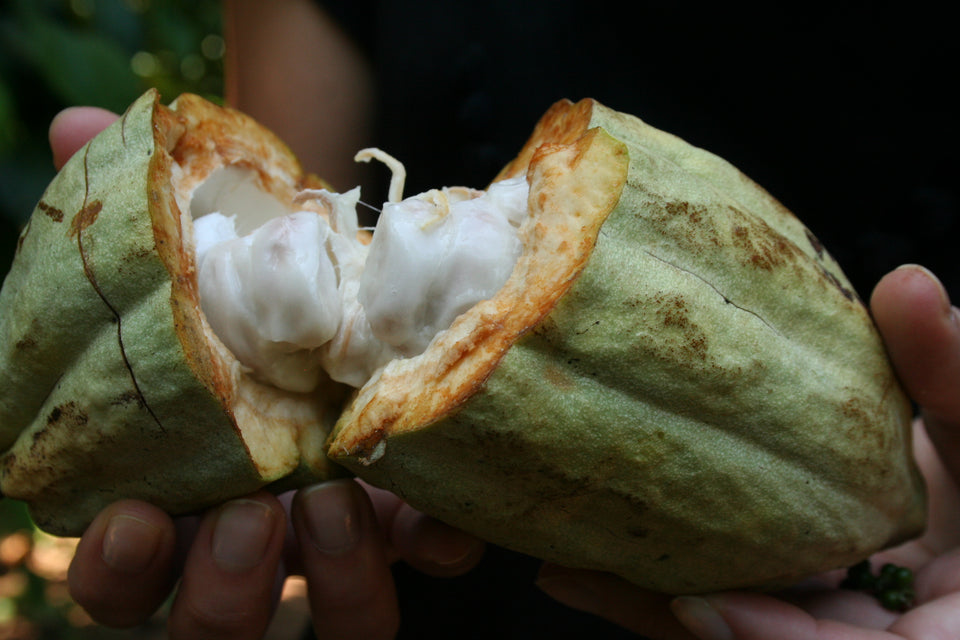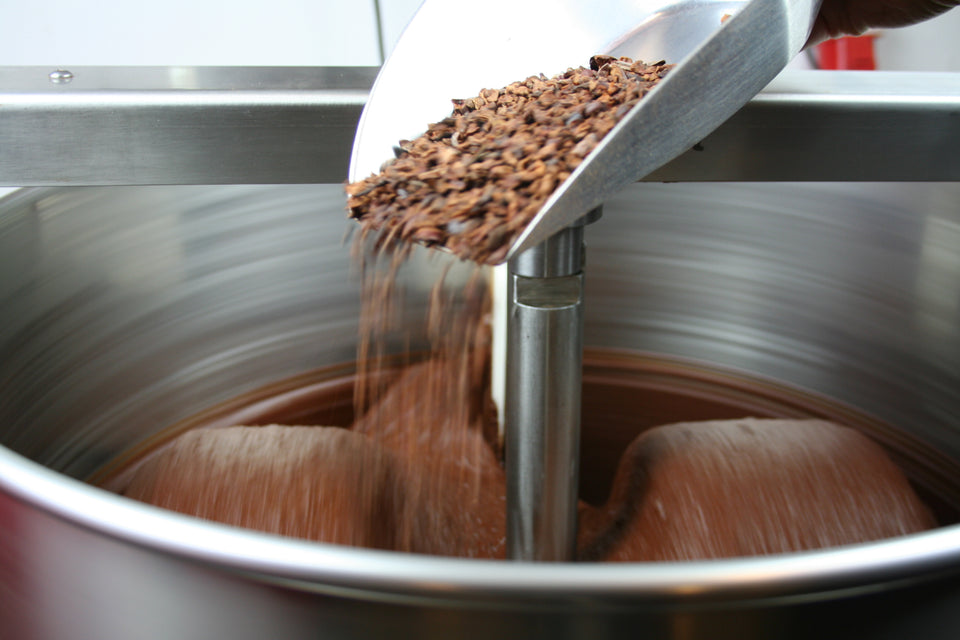

Svenska Kakao - Swedish Bean to bar
HOW IS CHOCOLATE MADE?
At Svenska Kakao, we manufacture artisan chocolate "bean-to-bar" based on the motto of always prioritizing quality and taste. Unlike many chocolate brands that buy ready-made mass from the industry and remelt it into the chocolate bars you see in the trade, we start from high-quality cocoa beans that we buy from selected origins around the world. By having control over all stages of cocoa from fruit on a tree to finished chocolate product, we can also provide an exceptional chocolate quality that is also produced in an ethical, sustainable and fair way. Which is a higher standard than regular organic and fair trade certified products.
Making chocolate is a long and arduous process that requires cooperation, knowledge, experience and patience. Let us take you on the journey from cocoa fruit to chocolate cake.
THE COCOA FRUIT
It all starts with the Theobroma cacao tree, which means "food of the gods" in Latin and is grown in regions around the equator. Cacao is believed to have originated in the upper Amazon region of Peru and was first cultivated by the Mayans and Aztecs. The cacao tree forms the basis of all chocolate produced across But the genetics of the cocoa beans as well as growing conditions such as terroir and weather play a significant role in quality and taste if they are to be used for chocolate production.
COCOA FRUIT HARVEST
Harvesting cacao fruit is the first crucial step in the process of producing high quality chocolate. The fruits are transformed from small pollinated flowers on the trunk of the cacao tree, and it takes about 140 days for the fruits to fully ripen after pollination. It is crucial to harvest a cacao fruit when it has reached perfect maturity. If they are harvested too early, there is not enough sugar in the pulp to promote good fermentation. If they are harvested too late, the bean may begin to germinate in the fruit and then it can no longer be used to make chocolate. When the fruits are ripe, they are carefully cut from the trees by hand and gathered in piles to be opened and emptied of clusters of cocoa beans surrounded by white pulp. This process is usually carried out in the field, and the empty pods are left to decompose and contribute nutrients to the soil.
FERMENTATION / FERMENTATION OF COCOA BEANS
Fermentation of the cocoa beans is one of the most crucial steps in the entire chocolate making process. It is in the fermentation process itself that the chocolate tones first appear in the beans. But you have to be quick. In principle, the harvested cocoa beans must be transported to a fermentation station within 24h. From the fruits being cut down from the trees. At the fermentation station, they are collected in piles or boxes to naturally ferment for 3-7 days. The fermentation enables a complex series of chemical reactions that not only prevent sprouting but also develop all the flavor notes into what is later judged to be a good chocolate flavor in a finished product. This process is dependent on the skill and experience of the grower as it directly determines the quality and taste of the finished cocoa. We rely to a great extent on the expertise of the producers we collaborate with to give us the best conditions to later produce world-class chocolate.
DRYING OF COCOA BEANS
Drying is the next crucial step in the process. This is the step that can turn a mediocre cocoa bean into something extraordinary. As the amount of water in the beans decreases, fermentation begins to slow down, but the flavor and color of the bean continues to develop and change. Slow and careful sun drying can, for example, reduce the acidity of a bean and at the same time develop the characteristic brown color of the finished chocolate. This process takes about 5-7 days and is finished when the amount of water in the bean reaches 6-8%. If the amount of water is too high, internal mold develops, which makes the beans unusable (At least for our part). The beans are then sorted before being packaged and sent to our small factory in Österlen.
ROASTING OF COCOA BEANS
When the cocoa beans arrive at our factory, our work begins to turn them into chocolate. First, we sort each bean by hand to ensure quality and size. After that comes the first and most crucial step to bring out the unique flavor of each cocoa bean, namely roasting. In the roasting process, a complex series of chemical reactions take place that take the flavor notes in the cocoa to the next level. At Svenska Kakao, we roast each bean quite lightly and carefully in our rotating convection ovens. We take the time to create a unique roasting profile for each origin and batch we receive. Carrying out this step correctly is of the utmost importance as it is crucial to producing good chocolate with the flavor notes preserved. Each bean origin is roasted differently depending on its flavor profile, allowing us to maximize the unique flavor of each bean.
SHEELING THE COCOA BEANS
The next step is to remove the thin cardboard-like shell from the roasted and now cooled cocoa bean. We crush the bean into small pieces and use air to separate the lighter skin from the heavier kernel. Removing all skin is essential, as it can introduce unwanted bitter flavors into the chocolate. The cocoa pieces, or cocoa nibs as they are also called, are collected and ready for the next step in the chocolate process. The peel can be used for tea or sometimes also as soil improvement in the garden.
COARSE GRINDING OF COCOA NIBS
We start by coarsely grinding cocoa nibs into a thicker paste. This initial grinding reduces the particle size of the cocoa nibs and begins to release the cocoa butter. Sugar can now be added to the ground cocoa nibs, also called chocolate mass, if a sweet chocolate is to be made. The sugar and chocolate mass are mixed and ground further before it is time for fine grinding.
FINE GRINDING OF THE CHOCOLATE MASS
The chocolate mass is poured into a machine that contains 40,000 steel balls whose task is to break the particles into smaller parts. After a while, the mass has been released on cocoa fat, which means that the mass now has the consistency of liquid melted chocolate.
CONCHING THE CHOCOLATE
After grinding the chocolate comes the next step, namely conching. In a machine that allows the chocolate to be rolled around, the chocolate is kneaded and properties such as viscosity, particle shape and taste are fine-tuned. This process usually takes between 24 and 72 hours, but the time can be shorter or longer depending on the chocolate. Through the right conching, the flavor notes in the chocolate are highlighted and come into their own while giving the chocolate a glossy, silky surface.
TEMPERING AND SHAPING
The chocolate has been through a lot at this stage and needs to rest for a short while. After resting, the chocolate is melted and ready for tempering. The chocolate mass is then temperature treated in a machine to stabilize the structure so that the natural cocoa fat is integrated throughout the chocolate. Correct tempering means that the chocolate that solidifies in its shape has a glossy and fine surface and has a stable and firm consistency at room temperature.



